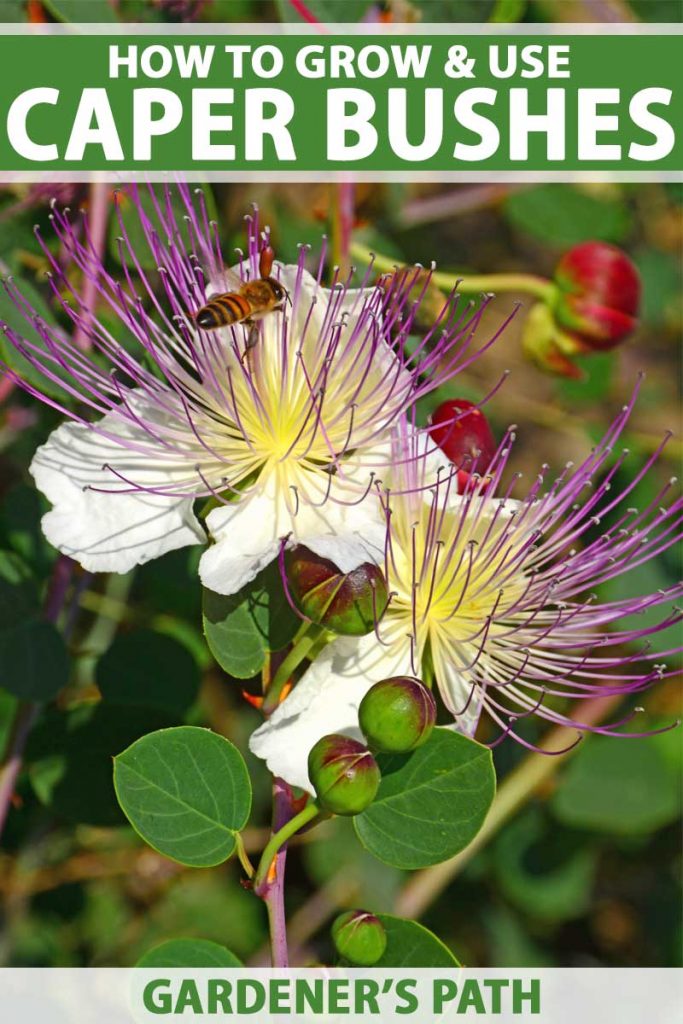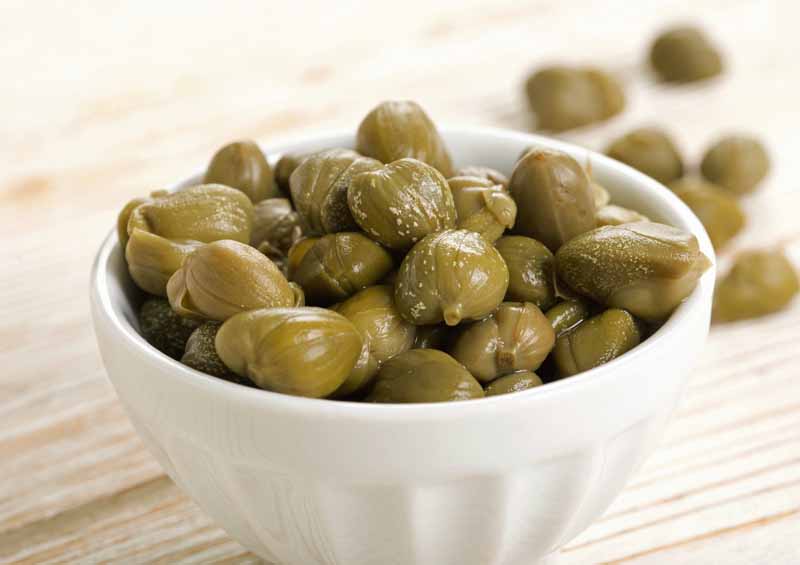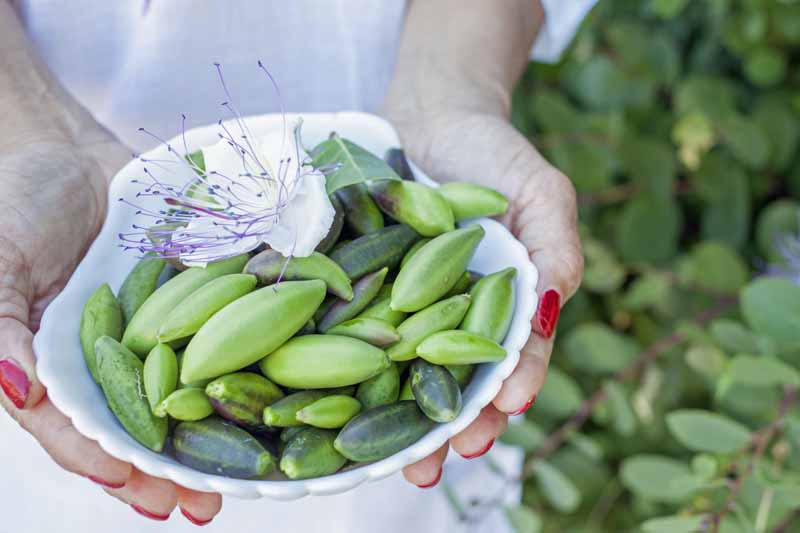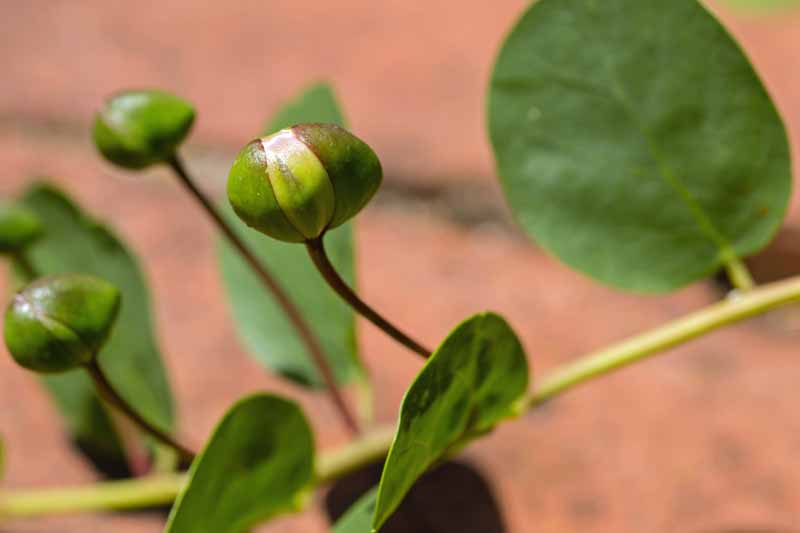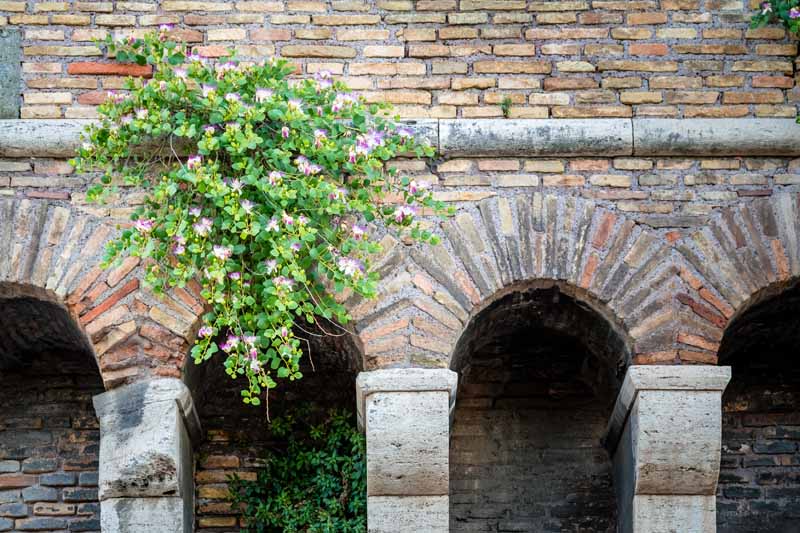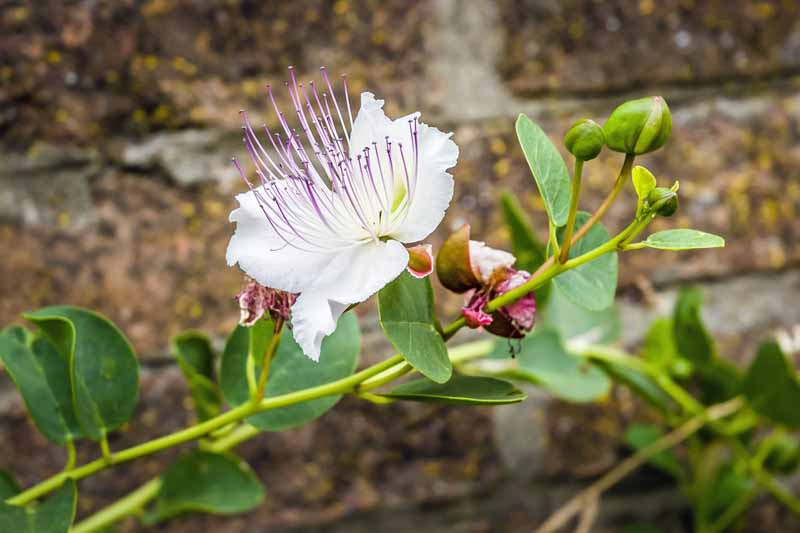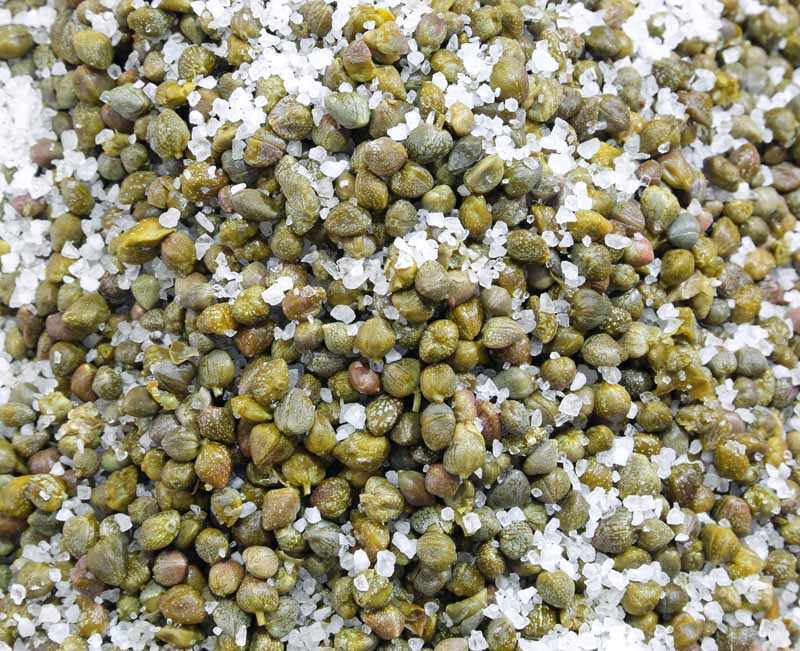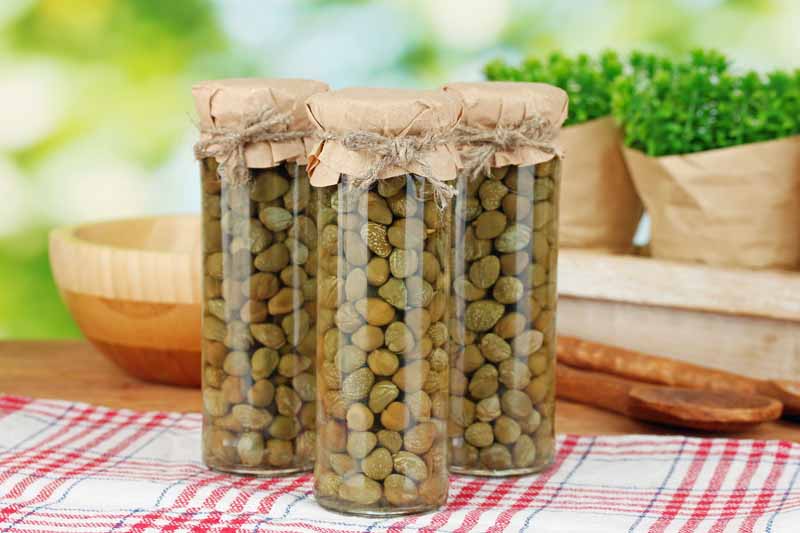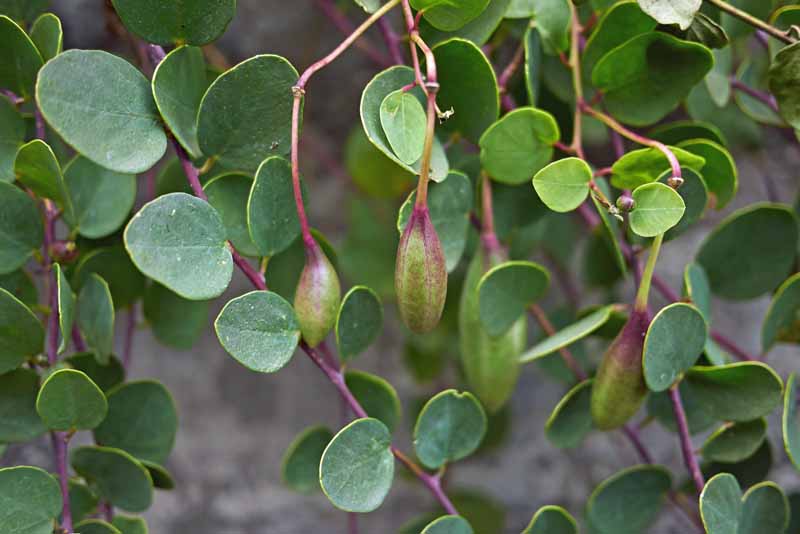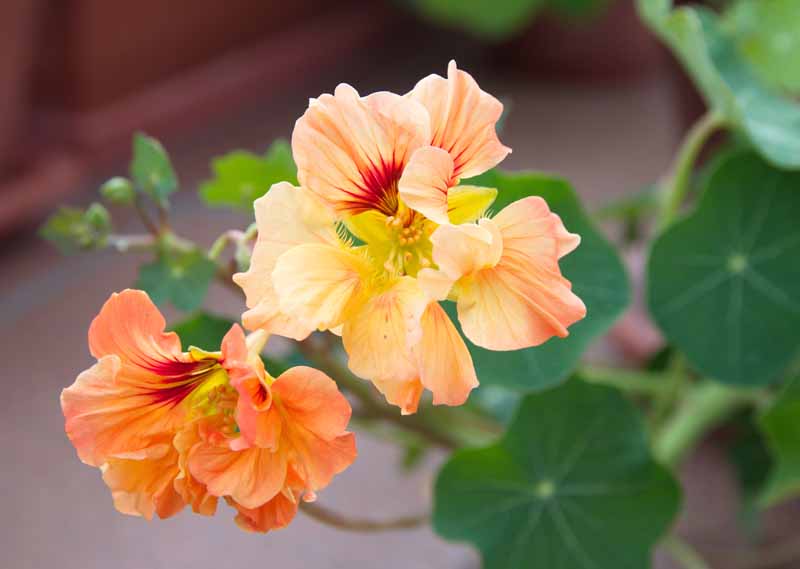And the caper bush fits this bill to a T. Edible flower buds that can be grown for food or beauty? I’m in! The tragic dichotomy of growing this plant, however, is that in order to harvest its delicious fruit, you rob the plant of its equally spectacular fragrant and white to light pink blooms, which are 2 to 3 inches across and feature numerous, dramatically long purple-pink stamens. We link to vendors to help you find relevant products. If you buy from one of our links, we may earn a commission. The solution is to plant twice as many shrubs as you might otherwise need. Let half bloom, and harvest the capers from the other half. Or you can let the flowers bloom, after which they will produce a caper berry.
Let’s learn more about growing this plant, which is also called Flinders rose.
What are Capers?
Capers are the edible flower bud of the many-branched caper bush, which also produces edible berries. Both are pickled before they are eaten, as they are very bitter when raw. Other parts of C. spinosa are used in medicines and cosmetics.
Olive-shaped C. spinosa berries are larger than caper buds, which are more roundish. Both, when pickled, have a piquant, tangy flavor, though the flavor of the buds is more intense. The berries are also starchier.
These pickled bits of goodness are typically used as a seasoning or condiment. They are especially delicious with fish and other oily or rich foods. The berries are sometimes served in cocktails.
Cultivation and History
Native to the Mediterranean, C. spinosa plants require dry heat and lots of sun to grow. They will not survive temperatures below 18°F. In their native environment, they are evergreen. In the caper bush diaspora, however, they may lose their leaves over winter.
In parts of the country where it gets cold, it’s best to grow C. spinosa in a container and let it overwinter indoors. Caper bushes can grow three to five feet high and spread four or five feet wide. They like well-drained, rocky soil similar to that favored by another beloved Mediterranean food plant, olive trees. They like masonry so much, they can be seen growing on the stone walls of ancient buildings throughout Italy!
Cultivation in the US isn’t rampant, although gardeners in the southwest and in parts of California have had some success. The climate where I live in Central Texas is often compared to that of the Mediterranean, but local experts that I consulted are unaware of a booming caper bush-growing phenomenon in our area. I might just have to start one!
Propagation
C. spinosa can be tricky to propagate, but here’s some information on the most commonly used methods:
From Seed
Seeds are best sown when fresh. If this is not possible, the seeds require cold stratification to germinate, and even with the best care, germination can be sporadic and lengthy — as long as three months. If seeds are not fresh, follow these steps:
From Cuttings
Keep in mind that your young plant won’t produce flowers for two to three years.
How to Grow
Growing Tips
Good drainage is critical. Water for two years, then let it be. Fertilize when plant is young.
Outsidepride Capparis Spinosa Seeds ‘Senza spina,’ for example, is an Italian spineless variety, whereas ‘spinosa comune’ is an Italian type that does have thorns. If you’re looking for a live plant, you might be able to find them in the spring at your local nursery.
Managing Pests and Disease
Insects
In the US, you may see weevils, which can be treated by sprinkling diatomaceous earth around the base of your plants. As of this writing, other insect pests that may affect capers are limited to the Mediterranean. Growers in Italy, Malta, South Africa, Spain, Argentina, and Turkey may be bothered by shield bugs such as Bagrada hilaras, which has been also spotted in California and Arizona. Check out this article to find out how to get rid of these pests. A number of species of flies, too, are known to bother plants growing in Italy, Malta, Algeria, Libya, Egypt, Pakistan, Tunisia, Jordan, and Indonesia. For these pests, try fly paper or insecticidal soap to get rid of them. Other pests may include butterfly and moth caterpillars which can be treated with Bacillus thuringiensis (Bt) or beneficial nematodes.
Disease
These bushes may be troubled by fungal infections, which can be treated with a fungicide. Cucumber mosaic virus (CMV) has been known to spread to caper bushes via aphid infestations, but thus far, this has been limited to the Anatolia region of southern Turkey.
Harvesting
The immature, tight flower buds are ready to pick when they are dark, olive green, and at least 6 millimeters wide (about 1/4 inch). You can also harvest them as they get larger, up to about 14 millimeters (a little over 1/2 inch), after which they’ll start expanding into their flower form.
The smaller they are, the more desirable, and therefore, the more expensive. Each size has been given a label, as follows:
Non-pareil: up to 7 mm Surfines: 7-8 mm Capucines: 8-9 mm Capotes: 9-11 mm Fines: 11-13 mm Grusas: 14+ mm
Pick them by hand in the morning when they’ve reached the size you desire. If your plant has thorns, be sure to wear gloves to protect your hands.
Preserving
Alas, unlike many other garden fruits such as tomatoes, capers cannot be eaten raw. Well, they can be, but they’re a bitter mouthful.
Much like olives, you can preserve capers with salt or with vinegar. For either, you’ll start by carefully picking through your harvest, removing stems and loose debris. Rinse thoroughly in a colander. Soak the capers in clean water for three days, changing the water every day.
To Preserve in Salt:
To Pickle:
Incidentally, the leaves are edible too, sometimes eaten raw but other times pickled.
Quick Reference Growing Chart
Recipes and Cooking Ideas
Now we get to the best part. The eating part. How about we start with a classic Greek salad? This one calls for chopped tomatoes, onions, and cucumbers, in addition to capers. And for the main course, consider Homemade Einkorn Ravioli with Sundried Tomato, Capers and Ricotta. Another main course option is Chicken Piccata, a classic use of these tasty orbs.
Or, Just Grow Nasturtiums
This plant is not widely grown in the US and I think we should change that, don’t you? Just look at those beautiful flowers! Why not add this beauty to your landscape and create a conversation piece? Your neighbors will be green with envy.
After this plant becomes established, it’s easy to care for, and drought tolerant. You can pick the flower buds or leave them. Just be sure to bring it indoors to overwinter, unless you live where temps don’t drop below 18°F. Are you willing to take a chance on something new and interesting — on a plant that gives back in the form of tiny green globes of goodness? Perhaps you’ve already grown a caper bush? Share your experience in the comments section below. If you’re looking for other flowering plants with edible blossoms or buds, consider these:
Borage (Borago officinalis) Pot marigold (Calendula officinalis) Lavender, various types Pansies (Viola tricolor)
© Ask the Experts, LLC. ALL RIGHTS RESERVED. See our TOS for more details. Product images via Outside Pride. Uncredited photos: Shutterstock.
